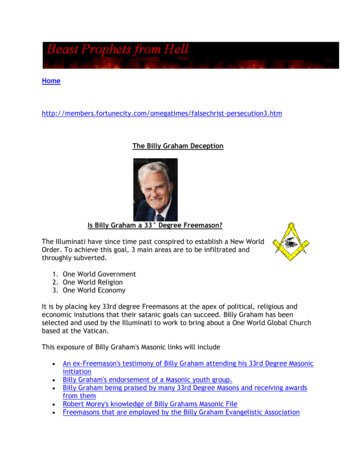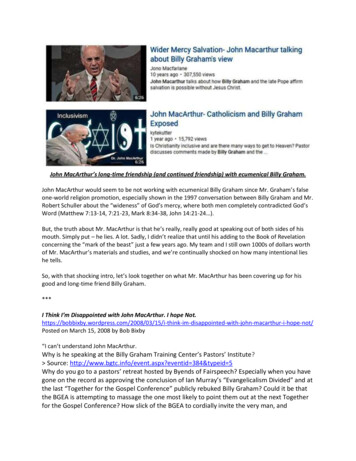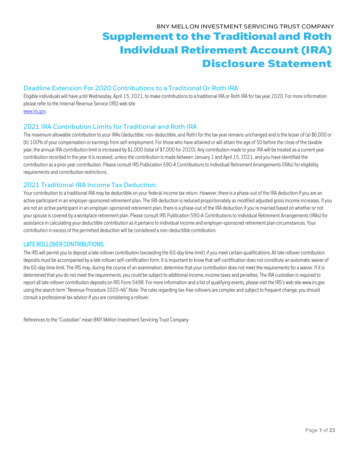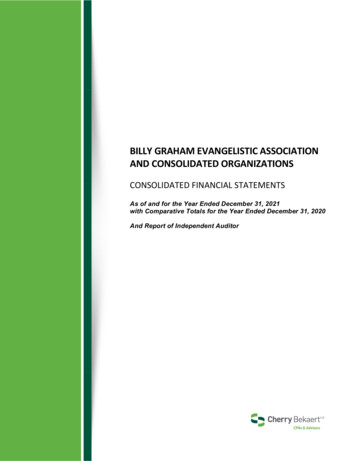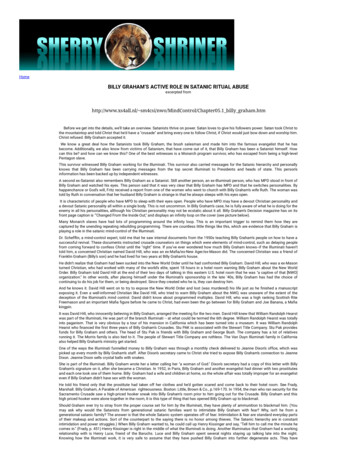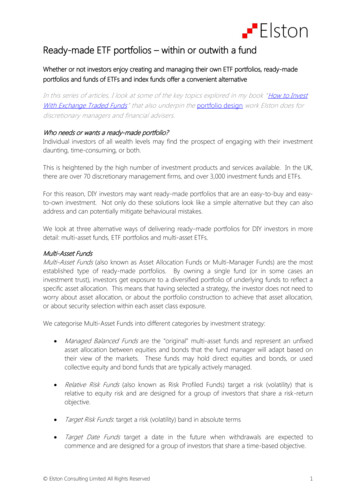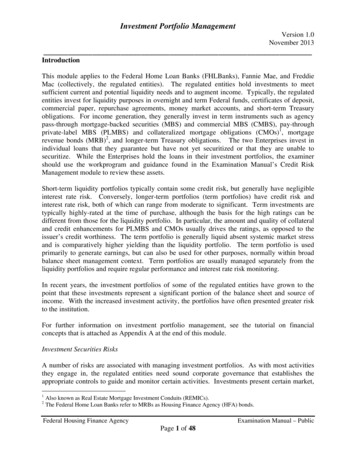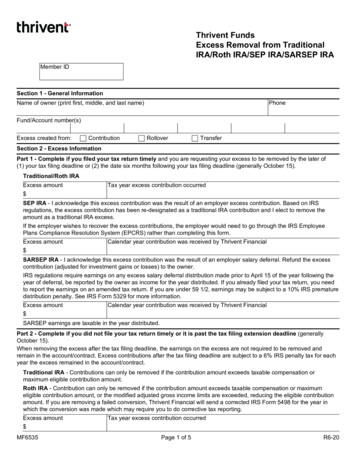
Transcription
Graham Capital ManagementResearch Note, March 2019Equal Risk Contribution PortfoliosErik Forseth1 , Ed Tricker2AbstractDecades since the introduction of modern portfolio theory by Harry Markowitz in 1952, portfolio optimizationremains an actively studied research problem. There exist any number of schemes for constructing the “optimal”portfolio, which run the gamut from simple rules of thumb to highly technical approaches founded on (e.g.)stochastic control theory. In recent years, a class of purely risk-based allocation programs have become popular.In this note, we review one method in particular: the equal risk contributions (ERC) portfolio. ERC is a robustoption not only for building portfolios of assets, but also for combining trading models in a multi-strategy fund.We attempt to elucidate the ERC methodology and give some intuition for its behavior.KeywordsPortfolio Construction, Equal Risk Contributions, Minimum Variance, Mean Variance1 Senior2 ChiefQuantitative Research AnalystInvestment Officer of Quantitative Strategies1. Introduction2. The Intuition Behind ERCThe mathematical problem of portfolio optimization has beenstudied extensively since the mean-variance framework wasfirst put forth by Markowitz (1952). The basic Markowitzportfolio finds an allocation vector w which minimizes riskwhile maximizing an expected return (effectively maximizingthe expected Sharpe Ratio):As we’ve alluded, the ERC portfolio does not require theinvestor to express a view on future expected returns1 . Ofcourse, in that sense, it is just one of many such approaches,the simplest of all being the naive 1/n equal weighting rule.The equally weighted portfolio invests equal dollar amountsin each constituent. ERC, on the other hand, tries to allocaterisk equally. Essentially, it postulates that without any stronga priori expectation about returns, the robust choice is to leteach constituent2 contribute equally to the portfolio’s overallvolatility.It’s helpful to think about how the ERC portfolio differsfrom the simple equal weighting scheme. The fundamentaldifference arises in ERC’s use of the covariance matrix, whichencodes information about both the volatility and the correlation structure among assets. That volatility is important isnot surprising. Intuitively, investors understand that an equaldollar allocation to stocks and bonds does not correspond toan equal risk allocation, since historically stock markets havebeen much more volatile than government bonds.Correlation effects are more subtle but just as important.Say we have three assets; the first two are perfectly correlatedand the third is uncorrelated with either of those two. Figure 1illustrates the situation, showing quite simply how mindingthe correlation can lead to a divergence between the equalweights and ERC portfolios.While these simple examples might shed some light, real1max f T w wT Σw,w2where f represents an estimate of the expected returns and Σis the covariance matrix.The classical Markowitz solution is not only important theoretically; it continues to be the ubiquitous baseline approachto portfolio building. Nevertheless, successful application ofthe method has its subtleties. Significant attention has beendevoted to the issue of regularizing Σ (Ledoit and Wolf, 2003;Karoui, 2008). Specification of f requires some forecast offuture expected returns, to which the final solution w can bequite sensitive.More recently, there is growing interest in allocation models which consider only the risk term, σ(w) wT Σw(portfolio risk),(1)some examples being the minimum variance and ERC portfolios (Maillard et al., 2010). Our focus in this note is on thelatter. We start by trying to build some intuition for how andwhy ERC makes the allocations it does. Next, we formalizethe problem and give the brief mathematical description ofthe approach. Finally, we draw some connections to minimum variance and describe when and why ERC might be anappropriate choice.1 Any view, that is, other than the implicit assumption that they are positivein the long run.2 Henceforth we’ll generically refer to the constituents of the portfolioas “assets,” with the understanding that these constituents could be financialinstruments such as futures contracts, or strategies within a multi-strategyfund. ERC is one solution to a more general allocation problem, for whichthe targets of allocation are not necessarily traditional investable assets.
Equal Risk Contribution Portfolios — 2/6Figure 1. Consider a portfolio of three assets with identical volatility, where the first two are perfectly correlated and the thirdis uncorrelated with either. The naive 1/n portfolio gives equal allocations to each asset, but the sources of risk are notbalanced. The ERC portfolio on the other hand finds allocations which ensure that the risk contributions are equalized.market data is more complicated and much more interesting.Figure 2 shows a set of results for a simulated ERC portfolioof futures contracts on three underlying instruments: the US30 Year Bond, the S&P 500, and the US Dollar Index. Thefigure shows rolling volatilities, correlations, and ERC allocations as a fraction of gross portfolio value. The allocationsare nonlinear functions of volatility and correlation, and whileit is not always obvious from visual inspection how they arebeing determined, the basic idea is that ERC down-weightspositively correlated and/or highly volatile assets (and viceversa). It becomes even more difficult to appreciate the behavior of the solution for portfolios of realistic dimension (e.g.dozens of constituents), but the same general principles willapply.3. The Mathematics of ERCHere we’ll try to formalize the concepts described thus far andgive a concise mathematical description of the ERC problem.In order to do this, we first need to define what we really meanwhen we talk about the “risk contribution” of an asset. It turnsout that the risk (1) has a special property which allows us todecompose it via the following sum3 :σ(w) Xiwi σ(w). wiThis says that the total risk of a portfolio can be written as asimple sum over the constituents. The derivative σ/ wi isknown as the “marginal risk contribution.” It represents theincrease in portfolio risk given an infinitesimal increase in theallocation to asset i. Multiplying the marginal contribution ofi by its current portfolio weight gives the full risk contributionfor that asset. We’ll denote these contributionsσi w i σ(w). wi3 The risk is a homogeneous function of degree one, meaning that σ(c ·w) c · σ(w). By Euler’s theorem we can write any such function as aninner product wT σ(w).
Equal Risk Contribution Portfolios — 3/6(a) Rolling dollar volatility for each of the three futures contracts.(b) Rolling correlations among each of the three pairs of instruments.(c) Rolling ERC allocations shown as a fraction of the dollarvolatility of the portfolio (so that they sum to one on any given day).Figure 2. A hypothetical ERC portfolio consisting of futures contracts on the US 30 Year Bond, S&P 500, and the US DollarIndex. Notice the effects on allocations during periods when volatility spikes, as it does for the S&P in 2018, or whencorrelations become substantially positive or negative, as they did in 2012.The goal of ERC is to set σi σj for all assets i and j in theportfolio; that is, we want the risk contribution from all assetsto be equal. Taking the derivative of σ with respect to w andsimplifying, this condition reduces to the requirement thatwi (Σw)i wj (Σw)j for all i and j,(2)where by (Σw)i we mean the ith component of the vectorΣw. The solution is found by numerically solvingminwXhwi (Σw)i wj (Σw)ji2.i,jOf course, we need to put some constraints on the solution(we can trivially equalize the risk contributionsP by settingw 0), so it’s typical to require wi 0 and i wi 1.3.1 Further ConnectionsThe ERC portfolio is closely related to another well-knownmodel called the “minimum variance” (MV) portfolio, whichsimply tries to minimize the overall risk without considerationfor individual allocations. Specifically, the problem is to solvemin wT Σw, subject towXwi 1.(3)iWhereas ERC equalizes the risk contributions among assets, itturns out that the MV portfolio actually equalizes the marginalrisk contributions introduced earlier. Recall, for asset i themarginal contribution is σ/ wi (Σw)i .To see that this is true, consider that the Lagrangian for
Equal Risk Contribution Portfolios — 4/6Figure 3. ERC allocations versus minimum variance allocations for the hypothetical portfolio described previously. Notice thatwhile the two solutions are generally very similar, the swings of the minimum variance method are more exaggerated. ERCtends not to let the allocation to any one constituent fall too low as a fraction of the overall portfolio.(3) is!L wT Σw λ 1 Xwi. Minimum VarianceXmaxwi subject to wT Σw 1wiiDifferentiating with respect to w and equating to zero, wefind1Σw λ1,2which says that each component of the vector Σw must beequal to the same constant λ/2 for some λ.How does ERC differ from the MV solution? As it turnsout, we can think of ERC as generally falling somewhere inbetween the simple equal weights portfolio on the one end,and the MV portfolio on the other (Maillard et al., 2010). Minimum variance can often give assets very little or even zeroweight, whereas ERC will only do so in extreme situations(e.g. when the correlation between a subset is exactly equalto -1). In this way, ERC can be thought to have a “minimumdiversification” requirement; it tends to ensure that there is atleast some nontrivial amount invested in each asset. HenceERC can be more robust from the perspective of not wantingto concentrate risk in any one constituent or subset of theconstituents. Figure (3) shows the two methods side-by-side.Finally, the investor must think carefully about her variousand possibly conflicting goals when deciding on a portfoliolayer. It’s typical to see both the MV and ERCPportfolioswritten with a “fully invested” constraint, i.e.i wi 1.This requirement may or may not make sense; for a long-shortfutures portfolio, for example, it is not appropriate. Here,the investor might instead prefer to bound overall portfoliorisk. In this case, the standard portfolio objectives become thefollowing: Mean-Variancemax µT w subject to wT Σw 1w Equal Risk ContributionsXmaxlog wi subject to wT Σw 1wiWriting them this way provides further insight. For example, we see that the minimum variance portfolio is the classical mean-variance portfolio with identical expected returns(µ 1), and the ERC portfolio is minimum variance with a“damped” utility function. To efficiently solve any of the aboveproblems, we can re-formulate them using second-order coneprogramming (SOCP), the details of which we omit here.4. ConclusionWeighting the constituents of a portfolio based on their riskcontributions is a robust choice in the absence of strong expectations about future returns. We’ve briefly shown the mathematical formalism behind ERC along with some simple examples. While ERC is just one of many options for makingallocation decisions, it is an eminently reasonable one under abroad set of assumptions. In fact, ERC is a powerful framework even beyond the generic setting of a long-only portfoliocomprised of investable financial assets. For example, consider allocating to trading strategies within a multi-strategyfund. The long-only constraint makes perfect sense here4 .Understanding and controlling for periods when strategiesget too volatile, or become highly correlated, is extremelyimportant. And if the investor has a prior that each strategyhas equal positive expected value, the right thing to do is tobe equally invested in terms of risk.4 Exceptunder very unusual circumstances, it would be hard to justifyshorting a strategy that you otherwise expect to be long-run profitable.
Equal Risk Contribution Portfolios — 5/6ReferencesN. E. Karoui. Spectrum estimation for large dimensionalcovariance matrices using random matrix theory. Annals ofStatistics, 36(6):2757–2790, 2008.O. Ledoit and M. Wolf. Improved estimation of the covariancematrix of stock returns with an application to portfolioselection. Journal of Empirical Finance, 10:603–621, 2003.S. Maillard, T. Roncalli, and J. Teı̈letche. The properties ofequally weighted risk contribution portfolios. The Journalof Portfolio Management, 36(4):60–70, 2010.H. Markowitz. Portfolio selection. The Journal of Finance, 7(1):77–91, 1952.
Equal Risk Contribution Portfolios — 6/6Legal DisclaimerTHIS DOCUMENT IS NOT A PRIVATE OFFERING MEMORANDUM AND DOES NOT CONSTITUTE AN OFFER TO SELL, NOR IS IT ASOLICITATION OF AN OFFER TO BUY, ANY SECURITY. THE VIEWS EXPRESSED HEREIN ARE EXCLUSIVELY THOSE OF THE AUTHOR(S)AND DO NOT NECESSARILY REPRESENT THE VIEWS OF GRAHAM CAPITAL MANAGEMENT, L.P. OR ANY OF ITS AFFILIATES (TOGETHER,“GRAHAM”). NEITHER THE AUTHOR NOR GRAHAM HAS ANY OBLIGATION, AND SHOULD NOT BE EXPECTED, TO UPDATE, CORRECT ORDELETE THE INFORMATION CONTAINED HEREIN IN LIGHT OF SUBSEQUENT MARKET EVENTS OR FOR ANY OTHER REASON. GRAHAMMAY TAKE POSITIONS OR MAKE INVESTMENT DECISIONS THAT ARE INCONSISTENT WITH THE VIEWS EXPRESSED HEREIN. THEINFORMATION CONTAINED HEREIN IS NOT INTENDED TO PROVIDE ACCOUNTING, LEGAL, OR TAX ADVICE AND SHOULD NOT BERELIED ON FOR INVESTMENT DECISION MAKING.THE INFORMATION SET FORTH HEREIN IS SUBJECT IN FULL TO THE TERMS OF USE OF THE GRAHAM CAPITAL MANAGEMENT WEBSITEAND MAY NOT BE REPRODUCED, MODIFIED, DISTRIBUTED OR OTHERWISE USED WITHOUT GRAHAM’S EXPRESS WRITTEN CONSENT.
Equal Risk Contribution Portfolios — 3/6 (a) Rolling dollar volatility for each of the three futures contracts. (b) Rolling correlations among each of the three pairs of instruments. (c) Rolling ERC allocations shown as a fraction of the dollar volatility of the portfolio (so that they sum to one on any given day). Figure 2. A hypothetical ERC portfolio consisting of futures contracts on the .
